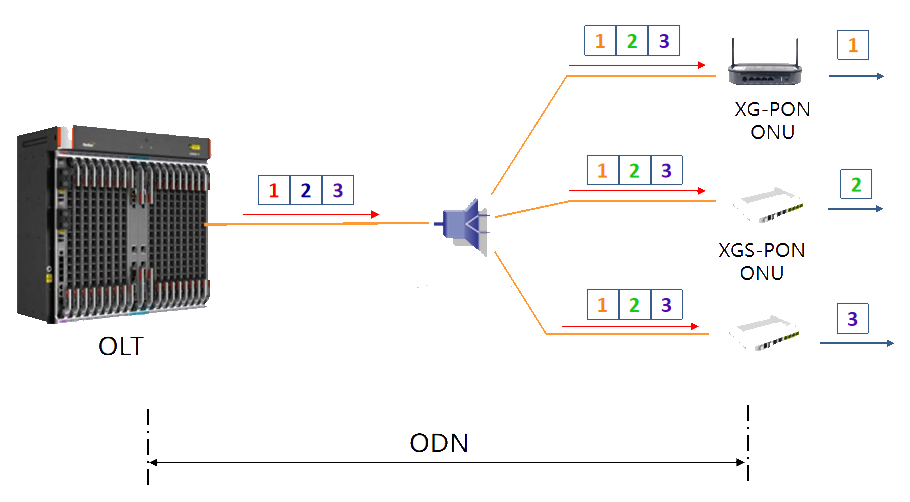About GPON, XG-PON, and XGS-PON
GPON is a passive optical network (PON) access technology based on the ITU-T G.984.x standard. It is regarded by more and more ISPs as an ideal solution for FTTx (especially FTTH) for its high bandwidth, good interoperability and manageability, high efficiency and other advantages. However, with the rise of PON and the demand for full services, people expect higher bandwidth performance, business support capabilities, network equipment access, etc. while protecting existing investments. Therefore, we are talking about the evolution of GPON to the next generation, that is, 10G GPON, including XG-PON and XGS-PON.
The main technologies currently used are GPON and XG-PON. Both GPON and XG-PON are asymmetric PONs. The bandwidth of XG-PON is 2.5 Gbps upstream and 10 Gbps downstream. As for GPON, it is 1.25Gbps upstream and 2.5Gbps downstream. In addition, the upstream speed of asymmetric PON is relatively low, and the cost of ONU components such as transmitting lasers is also low, so the overall equipment cost is low. However, with the emergence of services such as live broadcasting and video surveillance that require higher upstream bandwidth and symmetrical upstream and downstream links, XGS-PON came into being. XGS-PON is a symmetric PON with 10G upstream and downstream speeds. It is the evolution of GPON and XG-PON, and supports access to GPON ONU, XG-PON ONU and XGS-PON ONU.


A comparison of their key differences
GPON, XG-PON, and XGS-PON are different generations of Passive Optical Network (PON) technologies. Here’s a comparison of their key differences:
- GPON (Gigabit Passive Optical Network):
- Downstream speed: Up to 2.5 Gbps
- Upstream speed: Up to 1.25 Gbps
- Wavelengths: 1490nm downstream, 1310nm upstream
- Standard: ITU-T G.984
- First widely deployed PON technology
- XG-PON (10-Gigabit-capable Passive Optical Network):
- Downstream speed: Up to 10 Gbps
- Upstream speed: Up to 2.5 Gbps
- Wavelengths: 1577nm downstream, 1270nm upstream
- Standard: ITU-T G.987
- Asymmetric 10G PON technology
- XGS-PON (10-Gigabit-capable Symmetric Passive Optical Network):
- Downstream speed: Up to 10 Gbps
- Upstream speed: Up to 10 Gbps
- Wavelengths: 1577nm downstream, 1270nm upstream
- Standard: ITU-T G.9807.1
- Symmetric 10G PON technology
Key differences:
- Speed:
- GPON offers the lowest speeds
- XG-PON and XGS-PON both offer higher downstream speeds than GPON
- XGS-PON offers the highest upstream speed, matching its downstream speed
- Symmetry:
- GPON and XG-PON are asymmetric (different downstream and upstream speeds)
- XGS-PON is symmetric (same downstream and upstream speeds)
- Wavelengths:
- GPON uses different wavelengths than XG-PON and XGS-PON
- XG-PON and XGS-PON use the same wavelengths
- Compatibility:
- XG-PON and XGS-PON can coexist with GPON on the same optical distribution network
- Upgrading from GPON to XG-PON or XGS-PON typically requires changing the optical line terminal (OLT) and optical network units (ONUs)
- Use cases:
- GPON is suitable for residential and small business applications
- XG-PON and XGS-PON are better suited for high-bandwidth applications, businesses, and future-proofing networks
- Cost:
- GPON is generally the most cost-effective for lower bandwidth needs
- XG-PON and XGS-PON equipment is more expensive but offers higher performance
XGS-PON is the most advanced of these technologies, offering the highest symmetric speeds and is becoming increasingly popular for new deployments and upgrades to existing networks.
XGS-PON and XG-PON coexist
XGS-PON is the same as XG-PON, with broadcast mode for downlink and TDMA mode for uplink.
Since the downstream wavelength and rate of XGS-PON and XG-PON are the same, XGS-PON downstream does not distinguish between XGS-PON ONU and XG-PON ONU, and the optical splitter transmits the downstream optical signal to the same ODN link for each ONU XG(S)-PON (XG-PON and XGS-PON), each ONU chooses to receive its own signal and discards other signals.
XGS-PON upstream sends data according to time slots, and ONU sends data in the time slots allowed by OLT. OLT dynamically allocates time slots according to the traffic requirements of different ONUs and ONU types (Is it XG-PON or XGS-PON?). In the time slots allocated to XG-PON ONUs, the data rate is 2.5Gbps; in the time slots allocated to XGS-PON ONUs, the data rate is 10 Gbps.
It can be seen that XGS-PON naturally supports dual ONU hybrid access, XG-PON and XGS-PON.
XGS-PON and GPON coexist
Since the upstream and downstream wavelengths are different from GPON, XGS-PON adopts a combination solution to share ODN with GPON. The XGS-PON combination optical module is composed of GPON optical module, XGS-PON optical module and WDM combiner.
In the upstream direction, after the optical signal enters the XGS-PON Combo port, WDM filters the GPON signal and XGS-PON signal according to the wavelength, and then sends the signal through different channels.
In the downstream direction, the signals from the GPON channel and the XGS-PON channel are multiplexed through WDM, and the mixed signals are transmitted downstream to the ONU through the ODN. Due to the different wavelengths, different types of ONUs select the required wavelength through internal filters to receive the signal.
Since XGS-PON naturally supports coexistence with XG-PON, the XGS-PON Combo solution supports the mixed access of three ONUs: GPON, XG-PON, and XGS-PON. The XGS-PON Combo optical module is also called a three-mode Combo optical module (the XG-PON Combo optical module is called a dual-mode Combo optical module because it supports the mixed access of GPON and XG-PON ONUs.


